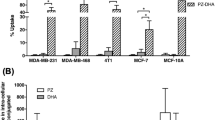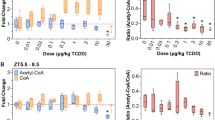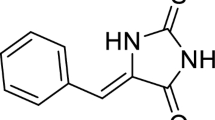Abstract
Six phenols [2(3)-t-butyl-4-hydroxyanisole (BHA), 2-t-butylphenol, 4-methoxyphenol, 4-methylmercaptophenol, t-butylhydroquinone and 2,6-di-t-butylphenol] previously shown to be inhibitors of benzo(a)pyrene-induced neoplasia, were examined for their ability to induce in vivo changes in hepatic mono-oxygenase and detoxication enzyme activities, and to act as mono-oxygenase inhibitors when added in vitro. (1) Generally it was found that cytochrome P450 levels were depressed, only 2,6-di-t-butylphenol caused a 2-fold induction (2) Mono-oxygenase activities were significantly altered, BHA and 2,6-di-t-butylphenol caused microsomes to show substantial increases in aniline hydroxylase and peroxidase activities. These microsomes, along with 4-methoxyphenol microsomes, also showed a substantial reduction in DNA binding of benzo(a)pyrene (BaP) metabolites relative to metabolism. (3) Detoxication enzymes glutathione S-transferases and epoxide hydratase were readily induced, the order of effectiveness being: BHA approximately 2,6-di-t-butylphenol greater than 4-methoxyphenol greater than 2-t-butylphenol approximately t-butylhydroquinone (4-methylmercaptophenol failed to induce). (4) in vitro ability to inhibit BaP metabolism and DNA-binding ability was: 2,6-di-t-butylphenol greater than or equal to BHA approximately 2-t-butylphenol greater than t-butylhydroquinone greater than 4-methylmercaptophenol greater than 4-methoxyphenol. (5) Ability in vitro to discharge the activated oxygen complex of cytochrome P450 was: 2,6-di-t-butylphenol approximately 2-t-butylphenol greater than BHA greater t-butylhydroquinone greater than 4-methylmercaptophenol greater than 4-methoxyphenol. The results are consistent with the theory that inhibition of neoplasia is related to inducibility of detoxication enzymes, though alterations in cytochrome P450 could play a significant role in some cases.
This is a preview of subscription content, access via your institution
Access options
Subscribe to this journal
Receive 24 print issues and online access
$259.00 per year
only $10.79 per issue
Buy this article
- Purchase on Springer Link
- Instant access to full article PDF
Prices may be subject to local taxes which are calculated during checkout
Similar content being viewed by others
Rights and permissions
About this article
Cite this article
Rahimtula, A., Jernström, B., Dock, L. et al. Effects of dietary and in vitro 2(3)-t-butyl-4-hydroxy-anisole and other phenols on hepatic enzyme activities in mice. Br J Cancer 45, 935–944 (1982). https://doi.org/10.1038/bjc.1982.146
Issue Date:
DOI: https://doi.org/10.1038/bjc.1982.146
This article is cited by
-
Protective effects of antioxidants against endrin-induced lipid peroxidation, glutathione depletion, and lethality in rats
Archives of Environmental Contamination and Toxicology (1990)
-
Synthetic antioxidants and anticarcinogenesis (review)
Pharmaceutical Chemistry Journal (1985)



